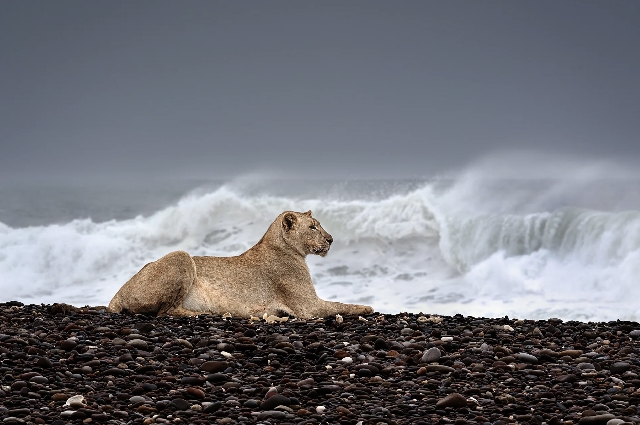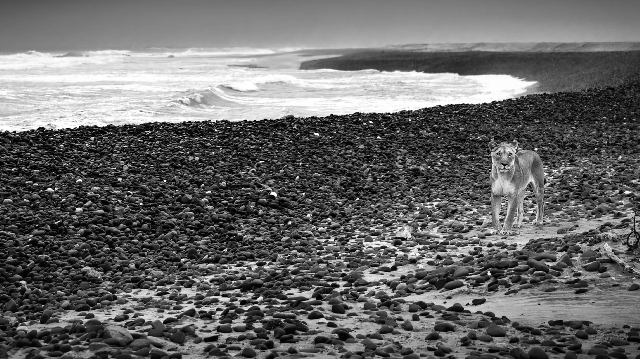'Their resilience is a lesson to us all': The maritime lions hunting seals on the beach
 Griet Van Malderen (Pic):
Griet Van Malderen (Pic):
In Namibia, a group of desert lions have left their traditional hunting grounds for the Atlantic coast, to become the world's only maritime lions. One photographer captured this dramatic change in behaviour.
It is an incredibly striking photo: a lioness gazes into the distance on a pebbled beach in Namibia as tempestuous waves crash in the background. She guards her prey, just out of view – the carcass of a Cape fur seal.
Belgian photographer Griet Van Malderen captured this dramatic shot of Gamma, one of Namibia's desert lions who has learned to hunt seals to survive in the harsh environment of the Skeleton Coast. Her photo was highly commended at the prestigious Wildlife Photographer of the Year competition, run by the Natural History Museum in London.
"She was guarding the seal all day," Van Malderen says, who spent days waiting to capture the shot, watching Gamma from her car. "It's really amazing to see how their behaviour is starting to change."
There are just 12 desert lions living along the Skeleton Coast, out of a total population of around 80 in Namibia. They have moved from the arid Namib Desert to the Atlantic Ocean in search of food, drastically changing their diet and behaviour in 2017 to adapt to this new habitat – and appearing to thrive from the change.
"The photo shows how resilient these animals are… that they change their habitat to survive," says Van Malderen. "These lions are tough. Life is about survival and everything is a struggle."
Van Malderen has watched Gamma grow up, first encountering the lioness when she was three months old. She is now three-and-a-half years, "almost an adult," she says, adding that the lioness has become a fearsome hunter capable of killing 40 seals in a single night.
Gamma is a member of the first generation of lions to have grown up on the Skeleton Coast, says Philip Stander, a conservation expert who has been tracking Namibia's desert lions since 1980. He says Van Malderen's photo is "really significant" as it shows Gamma's "first day alone on the beach".
Namibia's desert lions used to live along the Skeleton Coast in the 1980s but retreated to the desert after a drought and conflict with farmers wiped out most of the population, says Stander. More than 30 years later, the animals "have found their way back to the coast", he says.
These animals have adapted to live in "the most inhospitable terrain you can imagine, a huge sea of sand dunes, with no vegetation", says Stander, who founded the non-profit Desert Lion Conservation Trust in 1997.
"The desert lions are incredibly unique," says Stander. They have the largest home range of any lion, he says, adding: "They are super fit, top athletes." The average home range of a desert lion is around 12,000 sq km (4,600 sq miles), he says, adding that a lion in the Serengeti would typically have a home range of around 100 sq km (39 sq miles). They have even adapted to survive without water. "They get most of their hydration from the meat they eat," Stander says.
"We're so used to seeing lions in a savannah habitat or lying on top of a big rock, like in The Lion King, so it's really striking to see one on a beach. It just feels very strange and unusual," says Natalie Cooper, a senior researcher in the life sciences department at the Natural History Museum in London.
The desert lions tend to travel in much smaller groups than savannah lions, says Cooper. "In general, with lions we see that in areas where there's more prey, they end up with more individuals per pride and also a smaller home range," she says. "In this area, they [roam] in small groups across massive distances in order to get enough food."
This makes the task of photographing the lions even more challenging. "As a photographer it is wonderful because these lions are always on the move," says Van Malderen. "They are not lying around and sleeping, but always hunting to survive."
 | Griet Van Malderen (Pic): Namibia's desert lions are the only known lions to hunt marine prey
| Griet Van Malderen (Pic): Namibia's desert lions are the only known lions to hunt marine prey
In 2015, the lions found the sea again and started hunting coastal prey on the beach, after a drought decimated their usual inland prey of ostriches, oryxes and springboks. "The seals were a blessing," says Van Malderen. "Climate change has pushed these desert lions to the edge, forcing them to adapt in extraordinary ways, to survive along the beaches of the Atlantic coast."
"It's amazing" to see the lions' changing behaviour across several generations, she says. The first desert lioness to be studied over 30 years ago "was specialised in [hunting] giraffes," she says. "Now this seal colony is giving these lions a little breathing space."
Two cubs were born at the coast in March 2025, Van Malderen adds. "It is going to be very interesting to follow this evolution."
Namibia's desert lions are the only known lions to hunt marine prey. "We refer to them as maritime lions because they have learned to understand the ocean ecosystem and to consume food from the ocean," says Stander.
A study by Stander found that cormorants, flamingos and seals accounted for 86% of the biomass consumed by the three young lionesses over a period of 18 months.
"Even though it's a small population of lions, [we hope] that they will recover now with the knowledge of the ocean. But we have to protect them," says Stander.
This means minimising conflict with humans living along the Skeleton Coast. Lion rangers are using fireworks to scare lions off when they come too close to human settlements, says Stander. They have also created a virtual fencing system which sends out an alert when the lions cross it, to protect people living in the area as well as tourists, he says.
Photography also plays an important role when it comes to conservation.
Van Malderen says the main goal of her work is to promote the protection of the species she photographs. "[My photos highlight] the beauty but also the fragility of these animals. Their resilience is a lesson to us all. To face change, to adapt and to act before it is too late," she says.
Stander agrees that the photo transmits "such a beautiful lesson to us all that animals have the ability to recover and regain the beauty and strength that they are known for. We just need to give them a chance".
Source: bbc.com
Trending Entertainment

Judge dismisses Drake’s lawsuit over Kendrick Lamar’s ‘Not Like Us’ diss track
01:40
Kid author Sarah Kittoe up for the highly coveted British Citizen Youth Award
08:47
My new song is inspired to correct ‘spiritual errors’ in the lives of people - Philipa Baafi
18:16
Ghana to celebrate the Life and legacy of Highlife legend Daddy Lumba on December 6
09:37
One iPhone led police to gang suspected of sending up to 40,000 stolen UK phones to China
15:14
Hiowe Gblaka family seeks restoration of ancestral lands in Dangme kingdom
17:13
Ko-Jo Cue shares how he rose to fame in Kumasi
14:42
My first recorded song was terrible – Ko-Jo Cue
14:33
I didn’t abandon school to do music –Ko-Jo Cue
14:34
Dodowa Ngmayem festival 2025 celebrates culture, unity, and environmental stewardship
09:43



